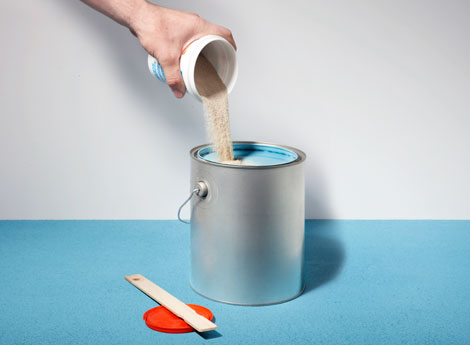How to Make a Slip-Proof Garage Floor: DIY Home
 Q: My garage floor is slippery when slush melts off the cars, which is bad news because I back the cars out and use the garage as a shop. Will painting the floor make it less slippery? The step on my garden tractor is also slick, especially when wet. I'm used to it, but my wife skinned her shin when she slipped on it. Now she won't use the tractor. Please suggest some solutions. Thanks.
A: It makes sense to correct these problems. Slip-and-fall accidents kill thousands of people every year and injure thousands more. In 2004, that amounted to about 18,000 deaths, according to the National Safety Council, a nonprofit organization dedicated to eliminating these and similar hazards.
Fortunately, the fix is easy.
"From an engineering point of view, there's required friction [the friction a person needs to walk safely] and the available friction [the friction the floor surface presents to the person]," says April Chambers, lab manager at the University of Pittsburgh's Human Movement and Balance Laboratory. "Your first goal to prevent a slipping accident is to ensure that available friction is greater than required friction." Translation: Add friction, add safety.
How aggressively you treat the surface depends on the severity of the slip hazard. In the case of your garage floor, I would treat it very aggressively, because a smooth concrete surface that has slush and water on it is almost as slippery as a surface can get. One solution is to apply rows of nonslip tape that has a very coarse, abrasive particle bonded to its face. One of the best is 3M's Safety-Walk; it's available in various levels of coarseness to suit the specifics of the application. I'd use the 700 series because it has the roughest surface and it resists moisture. You can also use it on the footing surfaces of tractors and trailers and on boat decks and docks. Porous surfaces need to be sealed with 3M Safety-Walk primer before the tape is applied.
Chambers cautions, however, that you never want to increase friction in a manner that creates a false sense of security. That is, taping one section of a slippery floor but not another can actually increase the chance of a fall as someone steps from a secure high-friction surface to one that's slippery.
A good way to uniformly increase the friction of a large area is to add abrasive particles to floor paint. Skid-Tex is a fine-grained silica sand that you can add to floor paint at the ratio of 1 pound per gallon. You simply stir it in and then paint as normal.
Don't Slip—Instead, SLP
Some years ago, I was cutting dovetails in a mahogany chest. The floor was littered with blocks of waste wood. I slipped on one and fell forward while holding the dovetail saw in my right hand. The saw raced down my left forearm, over my wrist, down my hand and over the tip of my index finger, splitting the nail in half. To avoid slips, just remember SLP: Sweep up, light up and pick up.
Sweep Up.
Don't let sawdust, planer shavings, wood chunks, metal filings or demolition debris accumulate where you work. Take a break and clear the floor as you work, and again when the job is done.
Light Up.
A dimly lighted area conceals hazards, especially at floor level. That's particularly dangerous in a work area where you'll likely be handling power tools. Light should be directed from above and from one side to fill in shadows.
Pick Up.
Stow boxes, work materials and subassemblies on shelves and sawhorses. It seems strange to think of the humble sawhorse as a safety aid, but it is. I build extras at every opportunity and use pairs of them just to keep stuff off the floor.
CALL THE PROS! All Housing Solutions to handle this and all your home improvement and repair needs! Contact Us Now
|

